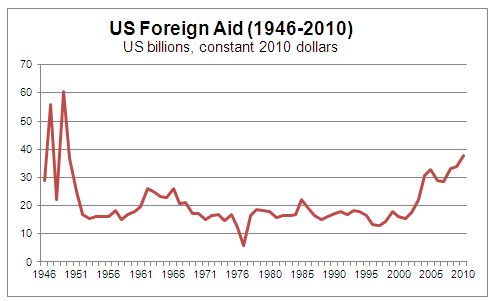The US government publishes something called the Greenbook (245 page pdf) which shows where all the US foreign aid goes, but you can get the same information on the website in a more useful and friendly way.
$38B in economic aid in 2010
This represents about 1% of the US national budget. There was $15B in military assistance, but will ignore that for now.
Going up for the last 10 years
Shown in the graph, aid was relatively flat at $15-20B (based on inflation adjusted 2010 dollars) between 1965-2000. The current level of $38B is where it was in 1953 time frame. For a good discussion on the trends of US foreign aid, look here.

Foreign aid goes to 180 countries
Aid gets scatter to almost every country in Africa, Eastern Europe, Latin America and Asia. Detailed data here.
On the surface, seems somewhat evenly distributed
Without doing a “foreign aid per capita calculation”, Africa and Asia appear to get about 1/4 of the total spend. Latin American and Eastern Europe share less than 20% of the aid. The Middle East trails with 9% of spend. The non-region specific aid probably includes some SG&A overhead costs and generic assistance.
Since Afghanistan (#1 recipient) and Pakistan (#2 recipient) are counted in Asia. Also, Egypt (#5 recipient) is counted in Africa. Israel receives no economic aid, but instead receives $2.8B in military assistance.
US foreign aid comes in many different forms
We build schools, provide drug therapies, dig wells, and even ensure fair elections. In the table below, you can see that US aid comes in 8 high-level buckets, with peace / security and health being the top two.
Each category can then be broken down
For example, the US spent $9B globally on health-related aid. The majority of this is spent on HIV/AIDS, compared to Malaria which only gets 1/10th of the funding.
Poverty is everywhere
In this chart below, you can see that in rural India or Pakistan, more than 70% of the people live on less than 2 dollars per day. The Economist points out here that 1 bad harvest can completely wipe these people out.
Aid is generous, but inconsistent
One of the key elements of building trust is consistency. So, when I downloaded the foreign aid data on a few of our key frenemies (friend + enemy), I can see why they are a bit confused on whether the US is a friend or a foe. Download the entire data set (all countries, all economic aid, 1946-2010).
US gave $4.6B in economic aid to Afghanistan in 2010
This is more than we gave the country for 56 years from 1946-2002. Understandably, a lot of this has history mixed up with the cold war, but it is not surprising that they might feel America is trying to force a “all-of-a-sudden” type relationship.
As you can see in the graph below, it looks like a yo-yo. It went from a high in the early 1960s, then dropped 90% to almost nothing in the early 1990s. Looks like a U shape and a U-turn in policy.
The US gave $1B in economic aid to Iraq in 2010
This is a lot of money – more than most countries receive from the US in aid – but it is only 1/8 of what Iraq received 2005. Digging deeper, it looks lie 2/3 of the “economic aid” was actually the Department of Defense helping out with “security assistance”. Does not sound very economic to me.
Mexico received about $622M in aid in 2010
We all too often forget our neighbor. US aid increased dramatically to Mexico, but in the form of more funding for narcotics control. If you read the news, the drug / gang violence in Mexico is at an all-time high.
US government aid is just a part of the equation
A reader wisely pointed out that the US government makes up just a small portion of the larger US overseas philanthropy. Completely agree. Don’t have to look any further than the Bill & Melinda Gates Foundation, Kiva.org, or a local church to see that Americans are eager to assist and invest in the developing world. Thanks for pointing that out.
US private capital flows were $161B in 2010
That is more than 4x more than what the US government sends overseas for development assistance. Look at this report from the Hudson Institute that shows how the contributors to overseas philanthropy are changing.
